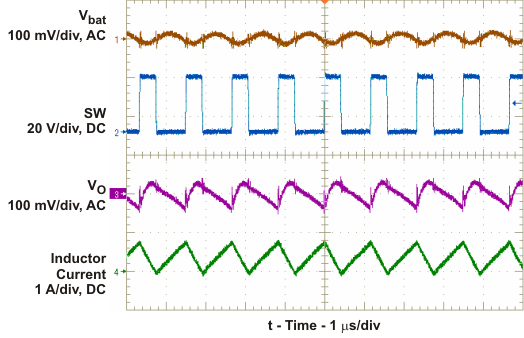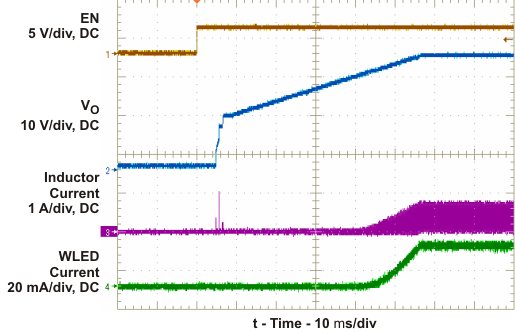SLVSAN6B February 2011 – September 2016 TPS61181A
PRODUCTION DATA.
- 1 Features
- 2 Applications
- 3 Description
- 4 Revision History
- 5 Device Comparison Table
- 6 Pin Configuration and Functions
- 7 Specifications
- 8 Detailed Description
- 9 Application and Implementation
- 10Power Supply Recommendations
- 11Layout
- 12Device And Documentation Support
- 13Mechanical, Packaging, and Orderable Information
7 Specifications
7.1 Absolute Maximum Ratings
over operating free-air temperature range (unless otherwise noted) (1)| MIN | MAX | UNIT | ||
|---|---|---|---|---|
| Voltage range(2) | VBAT and Fault | –0.3 | 24 | V |
| CIN and ISET | –0.3 | 3.6 | ||
| SW and VO | –0.3 | 40 | ||
| IFB1 to IFB6, EN and DCTRL | –0.3 | 20 | ||
| Continuous power dissipation | See Thermal Information | |||
| Operating junction temperature range | –40 | 150 | °C | |
| Storage temperature range | –65 | 150 | ||
(1) Stresses beyond those listed under Absolute Maximum Ratings may cause permanent damage to the device. These are stress ratings only, which do not imply functional operation of the device at these or any other conditions beyond those indicated under Recommended Operating Conditions. Exposure to absolute-maximum-rated conditions for extended periods may affect device reliability.
(2) All voltage values are with respect to network ground terminal.
7.2 ESD Ratings
| VALUE | UNIT | |||
|---|---|---|---|---|
| V(ESD) | Electrostatic discharge | Human-body model (HBM), per ANSI/ESDA/JEDEC JS-001(1) | ±3000 | V |
| Charged-device model (CDM), per JEDEC specification JESD22-C101(2) | ±200 | |||
| Machine mode (MM) | 1000 | |||
(1) JEDEC document JEP155 states that 500-V HBM allows safe manufacturing with a standard ESD control process.
(2) JEDEC document JEP157 states that 250-V CDM allows safe manufacturing with a standard ESD control process.
7.3 Recommended Operating Conditions
7.4 Thermal Information
| THERMAL METRIC(1) | TPS61181A | UNIT | |
|---|---|---|---|
| RTE (WQFN) | |||
| 16 PINS | |||
| RθJA | Junction-to-ambient thermal resistance | 43.1 | °C/W |
| RθJCtop | Junction-to-case (top) thermal resistance | 38.3 | °C/W |
| RθJB | Junction-to-board thermal resistance | 14.6 | °C/W |
| RψJT | Junction-to-top characterization parameter | 0.4 | °C/W |
| RψJB | Junction-to-board characterization parameter | 14.4 | °C/W |
| RθJCbot | Junction-to-case (bottom) thermal resistance | 3.6 | °C/W |
(1) For more information about traditional and new thermal metrics, see the Semiconductor and IC Package Thermal Metrics application report.
7.5 Electrical Characteristics
VBAT = 10.8 V, 0.1 μF at Cin, EN = logic high, IFB current = 20 mA, IFB voltage = 500 mV, TA = –40°C to 85°C, typical values are at TA = 25°C (unless otherwise noted).| PARAMETER | TEST CONDITIONS | MIN | TYP | MAX | UNIT | |||
|---|---|---|---|---|---|---|---|---|
| SUPPLY CURRENT | ||||||||
| VBAT | Battery input voltage range | 4.5 | 24 | V | ||||
| Vcin | Cin pin output voltage | 2.7 | 3.15 | 3.6 | V | |||
| Iq_bat | Operating quiescent current into VBAT | Device enable, switching no load, VIN = 24 V |
3 | mA | ||||
| IQ_sw | Operating quiescent current into VO | VO = 35 V | 60 | μA | ||||
| ISD | Shutdown current | EN=GND | 2 | 18 | μA | |||
| Vbat_UVLO | VBAT undervoltage lockout threshold | VBAT rising | 4.45 | V | ||||
| VBAT falling | 3.9 | |||||||
| Vbat_hys | VBAT undervoltage lockout hysteresis | VBAT rising – VBAT falling | 220 | mV | ||||
| EN AND DCTRL | ||||||||
| VH | EN pin logic high voltage | 2 | V | |||||
| VL | EN pin logic low voltage | 0.8 | V | |||||
| VH | DCTRL pin logic high voltage | 2 | V | |||||
| VL | DCTRL pin logic low voltage | 0.8 | V | |||||
| RPD | Pulldown resistor on both pins | VEN, DCTRL = 2 V | 400 | 800 | 1600 | kΩ | ||
| CURRENT REGULATION | ||||||||
| VISET | ISET pin voltage | 1.204 | 1.229 | 1.253 | V | |||
| KISET | Current multiple Iout/ISET | ISET current = 20 μA | 970 | 1000 | 1030 | |||
| IFB | Current accuracy | ISET current = 20 µA | 19.4 | 20 | 20.6 | mA | ||
| Km | (Imax – Imin) / IAVG | ISET current = 20 μA | 1% | 2.5% | ||||
| Ileak | IFB pin leakage current | IFB voltage = 20 V on all pins | 3 | μA | ||||
| IIFB_MAX | Current sink max output current | IFB = 500 mV | 30 | mA | ||||
| BOOST OUTPUT REGULATION | ||||||||
| VIFB_L | VO dial up threshold | ISET current = 20 μA | 400 | mV | ||||
| VIFB_H | VO dial down threshold | ISET current = 20 μA | 700 | mV | ||||
| Vreg_L | Min VO regulation voltage | 16 | V | |||||
| Vo_step | VO stepping voltage | 100 | 150 | mV | ||||
| POWER SWITCH | ||||||||
| RPWM_SW | PWM FET on-resistance | 0.2 | 0.45 | Ω | ||||
| Rstart | Start up charging resistance | VO = 0 V | 100 | 300 | Ω | |||
| Vstart_r | Isolation FET start-up threshold | VIN – VO, VO ramp up | 1.2 | 2 | V | |||
| ILN_NFET | PWM FET leakage current | VSW = 35 V | 1 | μA | ||||
| OSCILLATOR | ||||||||
| fS | Oscillator frequency | 0.9 | 1 | 1.2 | MHz | |||
| Dmax | Maximum duty cycle | IFB = 0 V | 94% | |||||
| Dmin | Minimum duty cycle | 7% | ||||||
| OS, SC, OVP AND SS | ||||||||
| ILIM | N-channel MOSFET current limit | D = Dmax | 1.5 | 3 | A | |||
| Vovp | VO overvoltage threshold | Measured on the VO pin | 38 | 39 | 40 | V | ||
| Vovp_IFB | IFB overvoltage threshold | Measured on the IFBx pin | 15 | 17 | 20 | V | ||
| Vsc | Short-circuit detection threshold | VIN – VO, VO ramp down | 1.7 | 2.5 | V | |||
| Vsc_dly | Short-circuit detection delay during start up | 32 | ms | |||||
| FAULT OUTPUT | ||||||||
| Vfault_high | Fault high voltage | Measured as VBAT – VFault | 0.1 | V | ||||
| Vfault_low | Fault low voltage | Measured as VBAT – VFault, sink 0.1 mA VIN = 15 V |
6 | 8 | 10 | V | ||
| THERMAL SHUTDOWN | ||||||||
| Tshutdown | Thermal shutdown threshold | 160 | °C | |||||
| Thysteresis | Thermal shutdown threshold hysteresis | 15 | °C | |||||
7.6 Typical Characteristics
Table 1. Table of Graphs
| Description (Reference to application circuit in Figure 16) | Figure | |
|---|---|---|
| Dimming Linearity | Vbat = 10.8 V; VO=28.6 V, 9 LEDs; Iset= 20 μA; PWM Freq = 1 kHz | Figure 1 |
| Dimming Linearity | Vbat = 10.8 V; VO=28.6 V, 9 LEDs; Iset= 20 μA; PWM Freq = 200 Hz | Figure 2 |
| Output Ripple | VO = 28.6 V; Iset= 20 μA; PWM Freq = 200 Hz; Duty = 50% | Figure 3 |
| Switching Waveform | Vbat = 10.8 V; Iset= 20μA | Figure 4 |
| Output Ripple at PWM Dimming | Vbat = 10.8 V; Iset = 20 μA; PWM Freq = 200 Hz; Duty = 50%; CO = 4.7 μF | Figure 5 |
| Short Circuit Protection | Vbat = 10.8 V; Iset = 20 μA | Figure 6 |
| Open WLED Protection | Vbat = 10.8 V; Iset = 20 μA | Figure 7 |
| Startup Waveform | Vbat = 10.8 V; Iset = 20 μA | Figure 8 |
| DC Load Efficiency | Vbat = 5 V, 10.8 V, 19 V; VO = 28.6 V, 9 LEDs; L = 10 µH | Figure 10 |
| DC Load Efficiency | Vbat = 5V, 10.8 V, 19 V; VO = 31.7 V, 10 LEDs; L =10 µH | Figure 11 |
| PWM Dimming Efficiency | Vbat = 5V, 10.8 V and 19 V; VO = 25.5 V, 8 LEDs; PWM Freq = 1 kHz | Figure 12 |
| PWM Dimming Efficiency | Vbat = 5V, 10.8 V and 19 V; VO = 28.6 V, 9 LEDs; PWM Freq = 1 kHz | Figure 13 |
| PWM Dimming Efficiency | Vbat = 5V, 10.8 V and 19 V; VO = 31.7 V, 10 LEDs; PWM Freq = 1 kHz | Figure 14 |
| PWM Dimming Efficiency | Vbat = 5V, 10.8 V and 19 V; VO=34.8 V, 11 LEDs; PWM Freq = 1 kHz | Figure 15 |
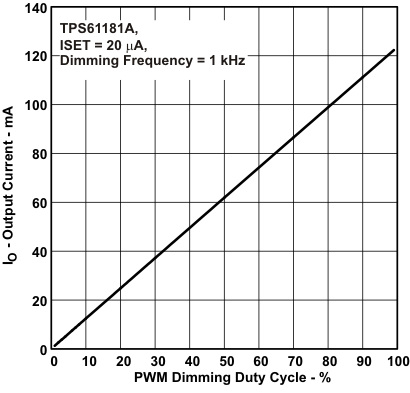
| 1 kHz |
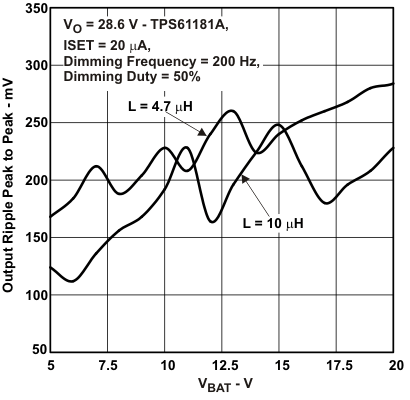
| COUT = 4.7 μF |
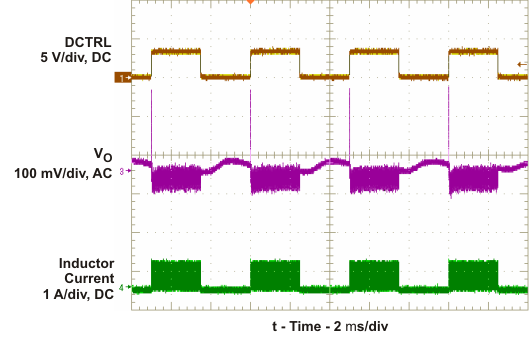
| COUT = 4.7 μF |
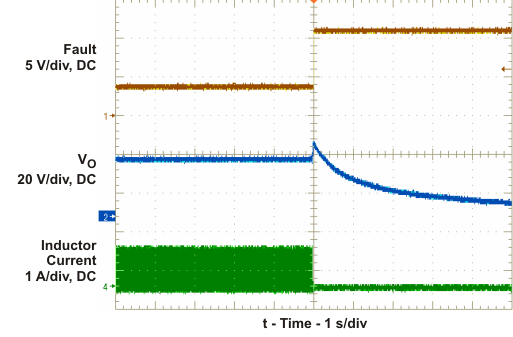
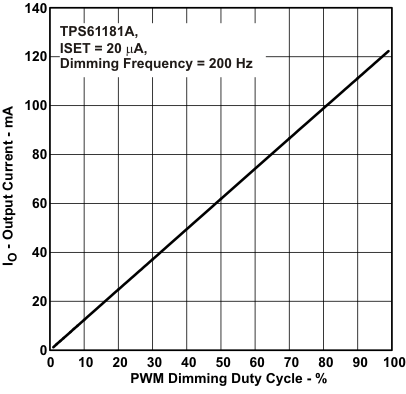
| 200 Hz |
